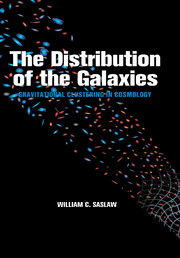Book contents
- Frontmatter
- Contents
- Prologue
- Part I Historical
- Part II Descriptions of Clustering
- Part III Gravity and Correlation Functions
- Part IV Gravity and Distribution Functions
- 21 General Properties of Distribution Functions
- 22 Dynamics of Distribution Functions
- 23 Short Review of Basic Thermodynamics
- 24 Thermodynamics and Gravity
- 25 Thermodynamic Formulation of the Cosmological Many-Body Problem
- 26 The Functional Form of b(n̄, T)
- 27 Derivation of the Spatial Distribution Function
- 28 Properties of the Spatial Gravitational Quasi-Equillibrium Distribution
- 29 The Velocity Distribution Function
- 30 Evolution of the GQED
- Part V Computer Experiments for Distribution Functions
- Part VI Observations of Distribution Functions
- Part VII Future Unfoldings
- Bibliography
- Index
23 - Short Review of Basic Thermodynamics
Published online by Cambridge University Press: 19 January 2010
- Frontmatter
- Contents
- Prologue
- Part I Historical
- Part II Descriptions of Clustering
- Part III Gravity and Correlation Functions
- Part IV Gravity and Distribution Functions
- 21 General Properties of Distribution Functions
- 22 Dynamics of Distribution Functions
- 23 Short Review of Basic Thermodynamics
- 24 Thermodynamics and Gravity
- 25 Thermodynamic Formulation of the Cosmological Many-Body Problem
- 26 The Functional Form of b(n̄, T)
- 27 Derivation of the Spatial Distribution Function
- 28 Properties of the Spatial Gravitational Quasi-Equillibrium Distribution
- 29 The Velocity Distribution Function
- 30 Evolution of the GQED
- Part V Computer Experiments for Distribution Functions
- Part VI Observations of Distribution Functions
- Part VII Future Unfoldings
- Bibliography
- Index
Summary
Now the resources of those skilled in the use of
extraordinary forces are as infinite as the heavens
and earth, as inexhaustible as the flow of the
great rivers, for they end and recommence –
cyclical as are the movements of the sun and moon.
Sun TzuConcepts
Gravity is an extraordinary force and understanding its more profound implications for the cosmological many-body problem requires many strategies. So far, we have followed two broad avenues of insight into the instability and clustering of infinite gravitating systems: linear kinetic theory and numerical N-body simulations. Now we turn onto a third avenue: thermodynamics. Classical thermodynamics is a theory of great scope and generality. It survived the relativity and quantum mechanical revolutions of physics nearly intact. In part, this was because among all theories of physics thermodynamics has the least physical content. Its statements relate very general quantities that must be defined anew, through equations of state, for each specific application. With this view, it is natural to ask whether thermodynamics also subsumes gravitating systems.
The answer is yes, with certain caveats and qualifications. Results of gravitational thermodynamics – gravithermodynamics, or GTD for short – are often surprising and counterintuitive compared to the thermodynamics of ordinary gases. Specific heats, for example, can be negative and equilibrium is a more distant ideal. Basically, these differences are caused by the long-range, unsaturated (unshielded) nature of gravitational forces. As a result, rigorous understanding of GTD is less certain than for ordinary thermodynamics. The present situation is a bit similar to the early thermodynamic gropings of Watt, Carnot, Kelvin, and Joule.
- Type
- Chapter
- Information
- The Distribution of the GalaxiesGravitational Clustering in Cosmology, pp. 278 - 300Publisher: Cambridge University PressPrint publication year: 1999



